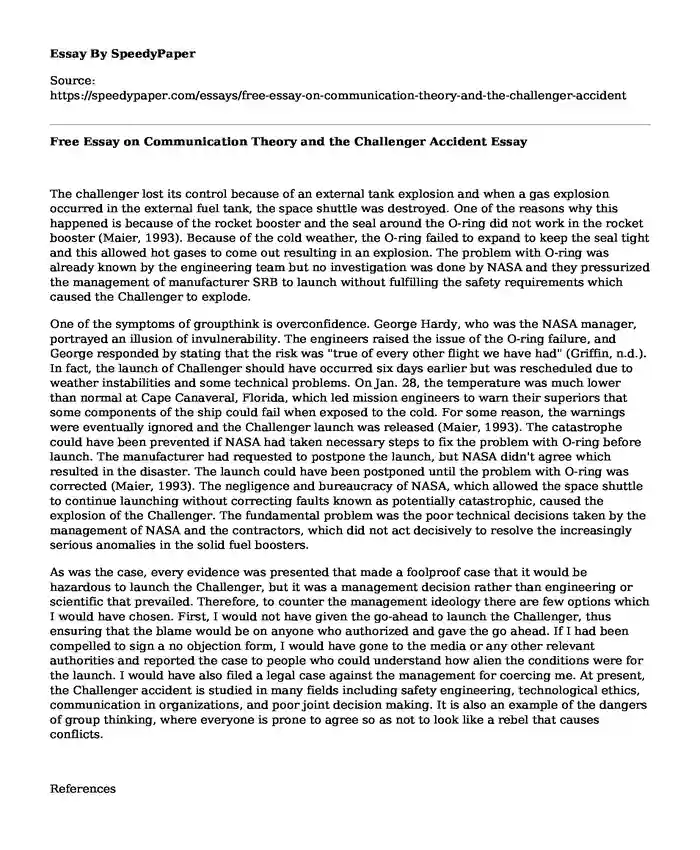
| Type of paper: | Essay |
| Categories: | Communication |
| Pages: | 3 |
| Wordcount: | 628 words |
The challenger lost its control because of an external tank explosion and when a gas explosion occurred in the external fuel tank, the space shuttle was destroyed. One of the reasons why this happened is because of the rocket booster and the seal around the O-ring did not work in the rocket booster (Maier, 1993). Because of the cold weather, the O-ring failed to expand to keep the seal tight and this allowed hot gases to come out resulting in an explosion. The problem with O-ring was already known by the engineering team but no investigation was done by NASA and they pressurized the management of manufacturer SRB to launch without fulfilling the safety requirements which caused the Challenger to explode.
One of the symptoms of groupthink is overconfidence. George Hardy, who was the NASA manager, portrayed an illusion of invulnerability. The engineers raised the issue of the O-ring failure, and George responded by stating that the risk was "true of every other flight we have had" (Griffin, n.d.). In fact, the launch of Challenger should have occurred six days earlier but was rescheduled due to weather instabilities and some technical problems. On Jan. 28, the temperature was much lower than normal at Cape Canaveral, Florida, which led mission engineers to warn their superiors that some components of the ship could fail when exposed to the cold. For some reason, the warnings were eventually ignored and the Challenger launch was released (Maier, 1993). The catastrophe could have been prevented if NASA had taken necessary steps to fix the problem with O-ring before launch. The manufacturer had requested to postpone the launch, but NASA didn't agree which resulted in the disaster. The launch could have been postponed until the problem with O-ring was corrected (Maier, 1993). The negligence and bureaucracy of NASA, which allowed the space shuttle to continue launching without correcting faults known as potentially catastrophic, caused the explosion of the Challenger. The fundamental problem was the poor technical decisions taken by the management of NASA and the contractors, which did not act decisively to resolve the increasingly serious anomalies in the solid fuel boosters.
As was the case, every evidence was presented that made a foolproof case that it would be hazardous to launch the Challenger, but it was a management decision rather than engineering or scientific that prevailed. Therefore, to counter the management ideology there are few options which I would have chosen. First, I would not have given the go-ahead to launch the Challenger, thus ensuring that the blame would be on anyone who authorized and gave the go ahead. If I had been compelled to sign a no objection form, I would have gone to the media or any other relevant authorities and reported the case to people who could understand how alien the conditions were for the launch. I would have also filed a legal case against the management for coercing me. At present, the Challenger accident is studied in many fields including safety engineering, technological ethics, communication in organizations, and poor joint decision making. It is also an example of the dangers of group thinking, where everyone is prone to agree so as not to look like a rebel that causes conflicts.
References
Crump, L., & Glendon, A. I. (2003). Towards a Paradigm of Multiparty Negotiation. International Negotiation, 8(2), 197-234.
Dyer, W. G., Dyer, W. G., Jr., & Dyer, J. H. (2013). Team building: Proven strategies for improving team performance (5th ed.). San Francisco, CA: Jossey-Bass.
Griffin, E. (n.d.). Groupthink of Irving Janis. In A First Look at Communication Theory
(Chapter 18). Retrieved October 22, 2018, from
http://www.afirstlook.com/archive/groupthink.cfm?source=archther
Maier, M. (1993). Teaching from Tragedy: An Interdisciplinary Module on the Space Shuttle Challenger. The Journal, 21(2), 91-94. Retrieved October 22, 2018, from Academic Search Premier.
Cite this page
Free Essay on Communication Theory and the Challenger Accident. (2022, Sep 09). Retrieved from https://speedypaper.com/essays/free-essay-on-communication-theory-and-the-challenger-accident
Request Removal
If you are the original author of this essay and no longer wish to have it published on the SpeedyPaper website, please click below to request its removal:
- Should College Tuition Be Affordable, Free Essay in Education
- Application Letter Example for Pre-doctoral Internship Training Program
- Free Essay with Summary of Ethical Dilemma
- Nursing Essay Sample: Personal Values and Beliefs of Nursing
- Cloud Computing Essay Example
- Essay Example Describing the "Unthing" Experiment
- Paper Example. Apple's Success
Popular categories




